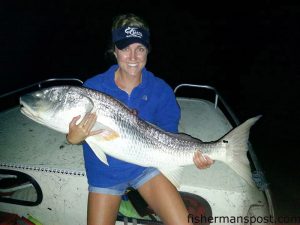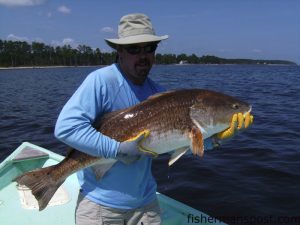Pamlico August 15, 2013

Laura Orr, of Topsail Beach, with a 42″ red drum she hooked on a small menhaden while fishing with her brother Rob off Ocracoke.
Gary, of Spec Fever Guide Service, reports that anglers are seeing some excellent action with citation-class (40”+) red drum in the lower Neuse River right now. Casting D.O.A. Airhead and 5.5” CAL soft plastics solo or under popping corks is tempting big numbers of bites from the big reds, and anglers are finding them pushing water near the shorelines and harassing schools of menhaden in the area.
Tarpon have shown up around the mouth of the Neuse, and the giant fish will take an interest in cut or live baits fished on the bottom where anglers spot them rolling.
Slot-sized red drum are feeding along the shorelines of the lower river, where anglers can hook them on D.O.A. shrimp under popping corks or cut baits on small Owen Lupton rigs.
A few flounder and speckled trout are also feeding near the pups, and they will bite soft plastics or live baits.
There’s still a decent striped bass bite for anglers working topwater plugs early and late in the day around New Bern. The best action has been along shoreline structure like stump fields, and anglers are also connecting with some puppy drum in the same areas.
Dave, of Knee Deep Custom Charters, reports the large red drum have shown up in the lower Neuse River in force, and anglers are hooking them both on bait and while working artificial lures. Soaking cut mullet or menhaden along the edges of shoals and ledges is the way to fool the old reds on baits, but anglers will have to check baits often as pinfish and bluefish are also taking a shine to them. Barbless circle hooks are required by law in the evening hours when targeting the big reds and should be used in the daytime as well to avoid gut-hooking the fish.
Searching for signs of the reds on the surface will give anglers opportunities to hook up on light tackle and large jigs paired with popping corks. A stealthy approach is vital in order not to spook the fish when anglers find them.

Jim Latoz, of Jacksonville, NC, with a 45″ red drum that struck a live finger mullet in the lower Neuse River and was released immediately after the photo.
Speckled trout, flounder, and slot-sized puppy drum are feeding along the shorelines of the lower river, but it can take some searching to find active fish. Soft plastics or live baits will tempt bites from all three.
Mitch, of FishIBX.com, reports that some large (40”+) red drum are moving into the Pamlico and Neuse Rivers, and the bite will get better as the month goes on. Anglers can target the big reds with artificials or by soaking bait, but it’s important to remember to handle the fish gently as they’re in the area to spawn.
Tarpon have been showing up in the same areas, and anglers may be able to locate rolling fish and set up near them with cut, dead, and live baits to hook up.
Casting artificial lures along the river shorelines is producing plenty of action with flounder and puppy drum.
Isaiah, of East Side Bait and Tackle, reports that anglers are still connecting with speckled trout, puppy drum, and flounder in the lower reaches of the Pamlico and Pungo rivers. Most of the fish are feeding along the shorelines, and anglers are fooling them with Gulp baits and topwater plugs.
Tarpon have been feeding around the mouth of the Pungo River, with a few sightings up around Willow and Wades points. Fishing large cut and dead baits on the bottom offers anglers the best odds of hooking up with one of the “silver kings.”
Citation-class red drum are in the Pamlico Sound and Neuse River, but they haven’t made much of a showing around the Pungo and Pamlico rivers. Most local anglers chasing the big reds are fishing around Garbacon Shoals and the mouth of the Neuse. Like the tarpon, cut baits on the bottom are the keys to hookups with the big reds.
